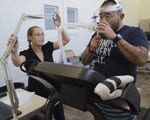“Newton figured out the laws of motion centuries ago but when we apply them to the human body it gets really complex, really quickly.” — Peter Weyand
Journalist Simon Usborne tapped the human-speed expertise of SMU biomechanics expert Peter Weyand for an article in the London newspaper The Guardian. The article examines the potential for humans to continue improving strength and speed beyond what has already been achieved.
Usborne interviewed Weyand for his expertise on the mechanics of running and speed of world-class sprinters like Usain Bolt. The article “How fast can we go? The science of the 100m sprint” published Oct. 3, 2016.
Weyand, director of the SMU Locomotor Performance Laboratory, is one of the world’s leading scholars on the scientific basis of human performance. His research on runners, specifically world-class sprinters, looks at the importance of ground forces for running speed, and has established a contemporary understanding that spans the scientific and athletic communities.
In particular, Weyand’s finding that speed athletes are not able to reposition their legs more rapidly than non-athletes debunked a widespread belief. Rather, Weyand and his colleagues have demonstrated sprinting performance is largely set by the force with which one presses against the ground and how long one applies that force.
Weyand is Glenn Simmons Centennial Chair in Applied Physiology and professor of biomechanics in the Department of Applied Physiology and Wellness in SMU’s Annette Caldwell Simmons School of Education and Human Development.
EXCERPT:
By Simon Usborne
The Guardian
The greatest race in the Olympics is the simplest. Eight runners, eight straight lines. A bang, an explosion of muscle and, less than ten seconds later, a winner. And all they do is run. No bikes, boats, vaults or horses — just one foot in front of the other. Yet, in those three dozen blinks of an eye, sprinters in the 100m perform physical feats so advanced that scientists are still trying to understand them.“On one level you’d think we would have pieced it together a long time ago,” says Peter Weyand, one of the world’s leading students of running and professor of applied physiology and biomechanics at South Methodist University in Dallas, Texas. “Newton figured out the laws of motion centuries ago but when we when we apply them to the human body it gets really complex, really quickly.”
Simply analysing the extreme motion and exertions of a sprinter is challenging. Weyand and his team have a large treadmill in their lab capable of rolling at 90mph. In the punishing max test, athletes straddle the moving belt and hop on for a few seconds at a time. They start slow, with rests in between. “We increase the speed until the athlete can’t maintain it,” the professor says. “We need eight steps without moving backwards for a good trial.”
The tests are a safer version of jumping off the back of an old Routemaster bus and staying upright for eight paces – athletes wear harnesses in case they trip – but how fast is the bus going? “The unofficial record on our treadmill is 11.72 metres per second,” Weyand says. That’s 26.7mph, or not far off a city speed limit, or Bolt’s peak speed during his 2009 world record run of 27.8mph. “When we have elite athletes do the test, the whole office comes over to watch.”
High-speed treadmills, slow-motion imaging and pressure sensors have allowed scientists to study aspects of elite sprinting that were largely unknown as recently as 15 years ago. “If you asked a coach in the late 1990s what they were doing it was all very much based on form,” Weyand says. “But when we started this work back at that time, the first thing we figured out is that what makes these guys fast is how forcefully they can hit the ground in relation to their body weight.”
When Usain Bolt looks like he’s floating over the track, he’s really not. That extreme rippling in the face that slow motion footage reveals in some runners demonstrates the forces that transfer from foot to floor. “We know that Bolt will peak out with each step at about five times his weight, while non-sprinting athletes will peak at about 3.5 times,” Weyand explains. “The science is clear: the top athletes are specialised to deliver the most force to the ground and that’s what makes them fast. But even now I think we’re still in the formative phase — it hasn’t yet translated into broad practices in training.”
Follow SMU Research on Twitter, @smuresearch.
For more SMU research see www.smuresearch.com.
SMU is a nationally ranked private university in Dallas founded 100 years ago. Today, SMU enrolls nearly 11,000 students who benefit from the academic opportunities and international reach of seven degree-granting schools. For more information, www.smu.edu.
SMU has an uplink facility located on campus for live TV, radio, or online interviews. To speak with an SMU expert or book an SMU guest in the studio, call SMU News & Communications at 214-768-7650.


 SMU biochemists and students probe biochemistry of membrane proteins that thwart cancer chemotherapies
SMU biochemists and students probe biochemistry of membrane proteins that thwart cancer chemotherapies One of the most significant Etruscan discoveries in decades names female goddess Uni
One of the most significant Etruscan discoveries in decades names female goddess Uni Textbook theory of how humans populated America is “biologically unviable,” study finds
Textbook theory of how humans populated America is “biologically unviable,” study finds Students grasp abstract math concepts after they demonstrate them with arm motions
Students grasp abstract math concepts after they demonstrate them with arm motions Geohazard: Giant sinkholes near West Texas oil patch towns are growing — as new ones lurk
Geohazard: Giant sinkholes near West Texas oil patch towns are growing — as new ones lurk Wildfire on warming planet requires adaptive capacity at local, national, int’l scales
Wildfire on warming planet requires adaptive capacity at local, national, int’l scales Early armored dino from Texas lacked cousin’s club-tail weapon, but had a nose for danger
Early armored dino from Texas lacked cousin’s club-tail weapon, but had a nose for danger SMU physicists: CERN’s Large Hadron Collider is once again smashing protons, taking data
SMU physicists: CERN’s Large Hadron Collider is once again smashing protons, taking data Nearby massive star explosion 30 million years ago equaled brightness of 100 million suns
Nearby massive star explosion 30 million years ago equaled brightness of 100 million suns


 NASA data leads to rare discovery: Earth’s moon wandered off axis billions of years ago
NASA data leads to rare discovery: Earth’s moon wandered off axis billions of years ago Good news! You’re likely burning more calories than you thought
Good news! You’re likely burning more calories than you thought New look at Pizarro’s conquest of Inca reveals foot soldiers were awed by empire’s grandeur
New look at Pizarro’s conquest of Inca reveals foot soldiers were awed by empire’s grandeur Charity, social justice and earth-friendly activism replace big houses, diamond rings and ostentatious living for status seekers
Charity, social justice and earth-friendly activism replace big houses, diamond rings and ostentatious living for status seekers National Center for Arts Research white paper counters findings of the Devos Institute Study on Culturally Specific Arts Organizations
National Center for Arts Research white paper counters findings of the Devos Institute Study on Culturally Specific Arts Organizations Long-term daily contact with Spanish missions triggered collapse of Native American populations in New Mexico
Long-term daily contact with Spanish missions triggered collapse of Native American populations in New Mexico North America’s newest pterosaur is a Texan — and flying reptile’s closest cousin is English
North America’s newest pterosaur is a Texan — and flying reptile’s closest cousin is English California 6th grade science books: Climate change a matter of opinion not scientific fact
California 6th grade science books: Climate change a matter of opinion not scientific fact